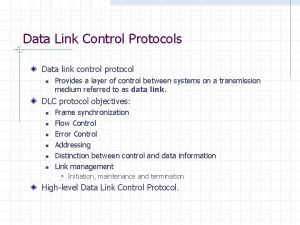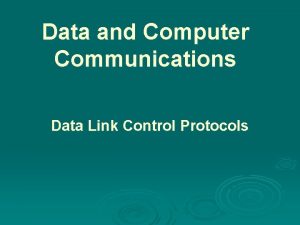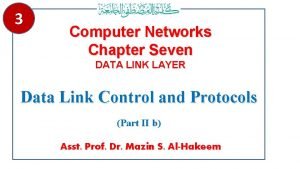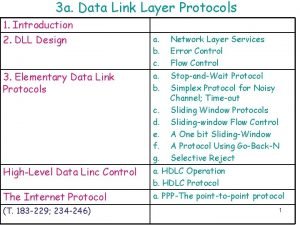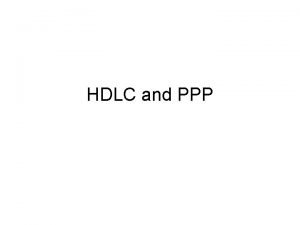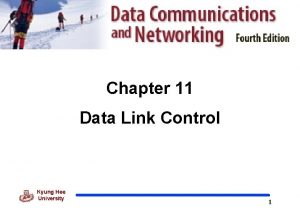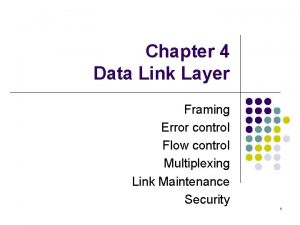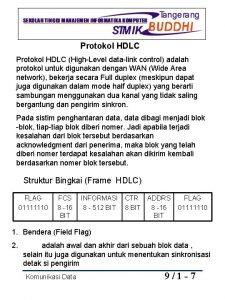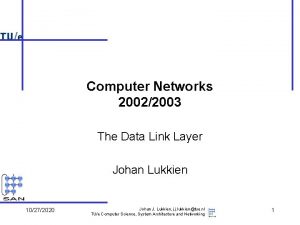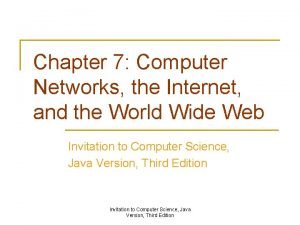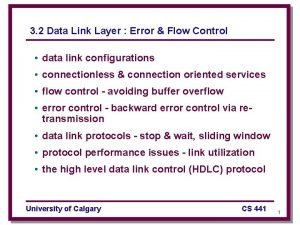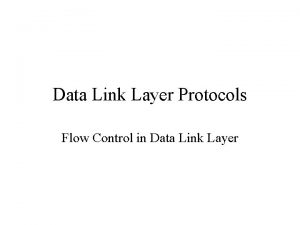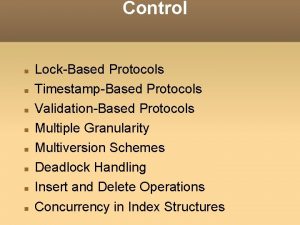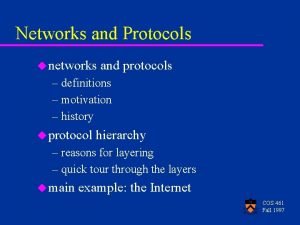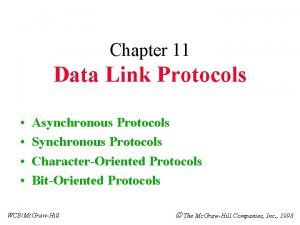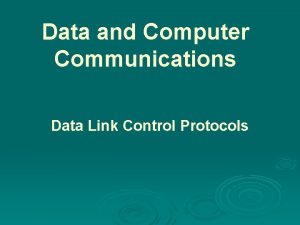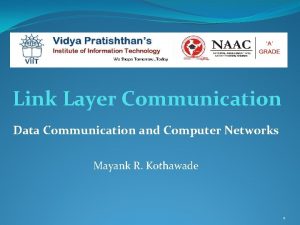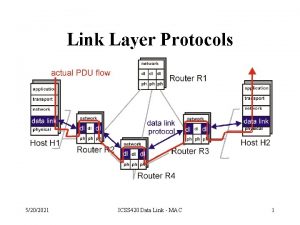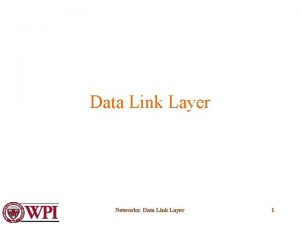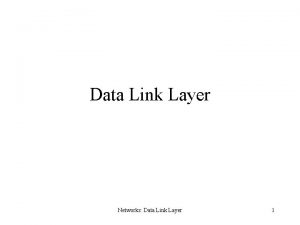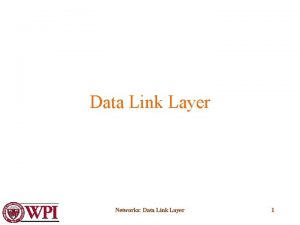1 DATA LINK CONTROL PROTOCOLS Networks and Communication

























- Slides: 25

1 DATA LINK CONTROL PROTOCOLS Networks and Communication Department Chapter 7

Lecture Contents 2 Flow control ARQ 21 -Dec-21 Networks and Communication Department

3 Flow Control 21 -Dec-21 Networks and Communication Department

Flow Control ensure sending entity does not overwhelm receiving entity � by preventing buffer overflow influenced by: � transmission time taken to emit all bits into medium � propagation time for a bit to traverse the link assume here no errors but varying delays

Model of Frame Transmission

Stop and Wait source transmits frame destination receives frame and replies with acknowledgement (ACK) source waits for ACK before sending next destination can stop flow by not send ACK works well for a few large frames Stop and wait becomes inadequate if large block of data is split into small frames

Stop and Wait Link Utilization

Sliding Windows Flow Control allows multiple numbered frames to be in transit receiver has buffer W long transmitter sends up to W frames without ACK includes number of next frame expected sequence number is bounded by size of field (k) � frames are numbered from 0 through 2 k - 1 � giving max window size of up to 2 k - 1 receiver can ack frames without permitting further transmission (Receive Not Ready) must send a normal acknowledge to resume if have full-duplex link, can piggyback ACks

use of a 3 -bit sequence number, so that frames are numbered sequentially from 0 through 7 * Window size = 7 Sliding Window Diagram

Sliding Window Example

11 Retransmission: ARQ 21 -Dec-21 Networks and Communication Department

Error Control detection and correction of errors such as: � lost frames � damaged frames common techniques use: � error detection � positive acknowledgment � retransmission after timeout � negative acknowledgement & retransmission

Automatic Repeat Request (ARQ) collective name for such error control mechanisms, including: stop and wait go back N selective reject (selective retransmission)

Stop and Wait source transmits single frame wait for ACK if received frame damaged, discard it � transmitter has timeout � if no ACK within timeout, retransmit if ACK damaged, transmitter will not recognize it � transmitter will retransmit � receive gets two copies of frame � use alternate numbering and ACK 0 / ACK 1

Stop and Wait see example with both types of errors pros and cons � simple � inefficient

Go Back N based on sliding window if no error, ACK as usual use window to control number of outstanding frames if error, reply with rejection � discard that frame and all future frames until error frame received correctly � transmitter must go back and retransmit that frame and all subsequent frames

Go Back N - Handling Damaged Frame � error in frame i so receiver rejects frame i � transmitter retransmits frames from i Lost Frame � frame i lost and either transmitter sends i+1 and receiver gets frame i+1 out of seq and rejects frame i or transmitter times out and send ACK with P bit set which receiver responds to with ACK i � transmitter then retransmits frames from i

Go Back N - Handling Damaged Acknowledgement � receiver gets frame i, sends ack (i+1) which is lost � acks are cumulative, so next ack (i+n) may arrive before transmitter times out on frame i � if transmitter times out, it sends ack with P bit set � can be repeated a number of times before a reset procedure is initiated Damaged Rejection � reject for damaged frame is lost � handled as for lost frame when transmitter times out

Selective Reject also called selective retransmission only rejected frames are retransmitted subsequent frames are accepted by the receiver and buffered minimizes retransmission receiver must maintain large enough buffer more complex logic in transmitter hence less widely used useful for satellite links with long propagation delays

Selective Reject The Only frames retransmitted are those that received negative acknowledgment , in this case called SREJ(NAK). or those that time out. More efficient than Go-back-N because it minimizes the amount of retransmission , but the receiver must maintain a buffer large enough post-SREJ frame until the frame in error is retransmitted

Go Back N vs Selective Reject

Selective Reject The window size limitation is more restrictive for selective-reject than for go back N. Consider the case of a 3 -bit sequence number size for selective-reject. Allow a window size of 7, and consider the following scenario : 1. Station A sends frames 0 through 6 to station B. 2. Station B receives all seven frames and cumulatively acknowledges with RR 7. 3. Because of a noise burst, the RR 7 is lost. 4. A times out and retransmits frame 0. 5. B has already advanced its receive window to accept frames 7, 0, 1, 2, 3, 4, and 5. Thus it assumes that frame 7 has been lost and that this is a new frame 0, which it accepts.

Selective Reject

Summary 24 For Flow Control we use techniques : stop and wait , sliding window. ARQ used for Error control, and it has three techniques: stop and wait , Go Back , selective. 21 -Dec-21 Networks and Communication Department

Reference: 25 Chapter 7 21 -Dec-21 Networks and Communication Department
 Flow control protocols
Flow control protocols Data link control
Data link control Utopian simplex protocol
Utopian simplex protocol Elementary data link protocols in computer networks
Elementary data link protocols in computer networks Data link layer protocols for noisy and noiseless channels
Data link layer protocols for noisy and noiseless channels Stop-and-wait arq
Stop-and-wait arq Ppp link protocol was terminated
Ppp link protocol was terminated Unrestricted simplex protocol
Unrestricted simplex protocol Jelaskan tentang error control pada data link control?
Jelaskan tentang error control pada data link control? Protocols and standards in computer networks
Protocols and standards in computer networks Switching in data link layer
Switching in data link layer Data link control
Data link control Piggybacking in go-back-n arq
Piggybacking in go-back-n arq Difference between virtual circuit and datagram subnet
Difference between virtual circuit and datagram subnet Flow control protocols
Flow control protocols Define hdlc
Define hdlc Data link control adalah
Data link control adalah Error control in data link layer
Error control in data link layer Protokol hdlc
Protokol hdlc Data link control
Data link control Data link control
Data link control Data link layer flow control
Data link layer flow control High level data link control protocol
High level data link control protocol Unrestricted simplex protocol
Unrestricted simplex protocol Rpc computer science
Rpc computer science Network communication protocols map
Network communication protocols map
